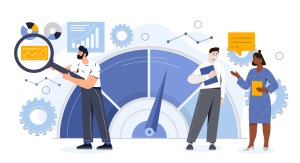By the time we come to the end of September and early October, “back to school” season is already well under way. Parents have bought their kids all the necessary supplies. Students have figured out their schedules and teachers have established classroom routines. It would be easy to overlook a different kind of back-to-school season that happens within workplaces – and at all times of the year.
Professional development is an ongoing and integral part of working in any field. It may or may not happen in a traditional school, but it requires a similar commitment to learning and embracing a beginner’s mindset when confronted with complex subjects.
In other words, some of the most successful people are always in a sort of back-to-school mode in order to stay current. It’s also known as upskilling or reskilling.
Salesforce’s 2022 Digital Skills Index shows just as important reskilling has become. While our intentions are good – nearly three quarters of Canadian respondents plan to learn new skills in the next five years – our execution leaves something to be desired. Only 14% are actively involved in digital skills learning and training programs right now. No wonder 81% of Canadians don’t’ feel equipped to learn the digital skills they need.
Part of the problem could be that individual employees aren’t always sure of how to pursue reskilling, or what kind of resources they need. This opens up a huge opportunity for employers, who have all kinds of incentives to support reskilling.
By helping employees find the time or even funding their professional development, companies could help drive greater engagement among their workforce. They could also earn greater loyalty among those they reskill, combatting the “Great Resignation” and reducing staff turnover. Most importantly, employees with the most current skills are in the ideal position to deliver the kinds of digital-first customer experiences that lead to long-term business growth.
Here’s one example of what a reskilling roadmap could look like – share it with your team members and discuss any differences in how they might approach it or what could be added here:
Sketch Out The Ideal Customer Experience Of The Future
Most of us understand how customers are interacting with your companies today, whether it’s working into a store to buy something or calling in an order over the phone. Listen to customer feedback on what they want and prefer, however, and you’ll begin to see where the right skills can help meet evolving expectations.
Think about how shopping has shifted over the last few years from largely in-store experiences to one that relies upon a best-in-class e-commerce experience. It will take the insights of experienced associates, IT professionals, marketers and others to make online shopping as seamless and as fun as traditional channels.
This can help set the stage for seeking out learning opportunities that will build upon what employees already know how to do.
Then:
Map All The Possible Career Pathways
Once a sales rep had a certain number of closed deals under their belt, they could reasonably expect to get promoted and become a more senior account manager. Perhaps one day they could become vice-president of sales. Those are still worthy goals, but they are by no means the only pathways open to a rep anymore.
Reps that learn how to make the most of platforms like a CRM can think about all sorts of career moves. These include becoming more of a sales analyst, unlocking insights from customer data and using visualization tools to explain business trends to other stakeholders.
The same holds true for those in marketing. They might start out running e-mail marketing campaigns, but learning how to harness technologies like artificial intelligence could turn them into a sort of Chief Personalization Officer, where they build deeper relationships between a brand and its customers.
You can do this exercise no matter your role or business function. Recognizing the potential to contribute to the business in more dynamic and higher-value ways will help you begin to set professional development goals that guides the learning opportunities you pursue.
Next:
Discover The Technologies That Will Drive Talent Needs
No one established courses in cloud computing until there was a critical mass of businesses moving away from on-premise applications and infrastructure. It’s no different than the rollout of technologies such as mobile computing, artificial intelligence and the Internet of Things. Companies develop innovations, and soon the market needs people who can master them in the field.
This is just one of many great reasons to attend an event like Dreamforce, to download eBooks that offer deep dives into the latest digital tools or to have conversations with industry analysts.
Seeing what’s in the market now – and what’s on the horizon – will flesh out your reskilling strategy considerably.
Then:
Evaluate The Best Mechanisms And Sources For Learning
Lots of working adults continue to go back to school, whether it be university or college, to reskill themselves. In some cases, though, that carries a cost and time commitment that not everyone can afford. Fortunately, there are plenty of other options.
Learning hubs like Trailhead can provide courses where you can earn valuable micro-credentials on your own time, for free. You can also join bootcamps and other short-term professional development programs where industry-specific certifications are taught in the evenings or on weekends.
There are also immersive learning opportunities that pair students directly with industry partners to get hands-on, practical exercises or internships to hone their new skills even further.
Regardless of how reskilling happens, just remember there’s always going to be more to learn. In that sense, going back to school doesn’t mean you’re taking time out from your day job. It means you’re investing your time in professional development that will move your career forward.

























